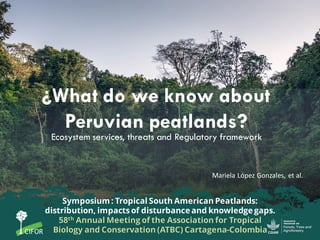
What do we know about Peruvian peatlands? : Ecosystem services, threats and Regulatory framework
- 1. ¿What do we know about Peruvian peatlands? Mariela López Gonzales, et al. Symposium: Tropical South American Peatlands: distribution, impacts of disturbanceand knowledge gaps. 58th Annual Meeting of the Association for Tropical Biology and Conservation (ATBC) Cartagena-Colombia Ecosystem services, threats and Regulatory framework
- 2. Peatlands • Oxygen deficient wetlands. Saturated condition allow peat formation. • 2,8 % of the Earth´sSurface(Xu et al. 2018) → 815 Gtof C in the soil (Yu et al, 2012). Perú: One of the richest countries in tropical peatlands (Gumbricht et al.2017).
- 3. I. Location • Ecosystem located in their three regions. • Predominance in the Amazon.
- 4. II. Ecosystems Region Estimated area of peatlands (km2 ) Ecosytem with potential to form peat Amazon 74 644# Palm swampforest Pole forest Grass-shrub swamp Floodplain forest Andes 13 800& Bofedal Paramo Jalca Coast n. d. Mangrove Coastalwetland # Gumbricht et al. (2017). & Solo en bofedales, según Chimner (2019 en Chimner et al. 2019). Palm swampforest Bofedal Mangrove
- 5. III. Importance- Ecosystemservices ❑ Important carbon reservoir →Pastaza Marañón (3% forest area)=3,1 Gt C (Draper et al.2014)(50% of C stored in aerial biomass of Perú) →Average C accumulation rates: up to 66 g C m-2 year-1 (Lähteenoja et al. 2009) →Peat dephts: ~7.5 m (Amazon) and up to 10.5 m (Andes). ❑ Regulation of the hydrological cycle
- 6. III. Importance ❑ Home to unique biodiversity ❑ Livelihoods of local communities ✓ Amazon: > 50 species form part of local community ✓ Andes: Animal husbandry is the main source of income ❑ Important part of the cultural roots of many indigenous communitites Macaws (Ara ararauna) Tapir (Tapirus terrestris) Agouti(Dasyproctaspp.) Mauritiaflexuosa fruit Cinclodes palliatus
- 7. IV. Threats • Amazon ✓ Explotation of oil and mining Resources (24% of peatlands in Pastaza are located in oil concessions,Roucoux et al.2017). ✓ Selectively felling female palms. ✓ Land-use change (plantations and rice fields expanded in Madre de Dios, Ucayali y San Martin). ✓ Overhunting - Anthropogenic
- 8. IV. Threats • The Andes ✓ Mining activities ✓ Road construction ✓ Overgrazing ✓ Peat extraction • Coast ✓ Population expansion ✓ Fires
- 9. V. Regulatory Framework • Commitment to conservation within the framework of the Ramsar Conventionon Wetlands. • Some peatlands areas are in protected zones. • Important regulations on mechanisms for the compensation of ecosystemservices • DS N° 006-2021 MINAM • There is no explicit inclusión in policies related to climate change: REDD + and NDC
- 10. Conclusions Peruvian peatlands… They play an importantrole in the fixationand storageof C, their conservation, sustainablemanagement and restorationare consideredkey among naturalclimate solutions. They are essential for adaptationto climate changethroughtheir provision of water- related ecosystemservices, such as water storageand regulation,buffering against floods, and waterpurificationat local and regional scales. They are fragile ecosystemsthatare being damaged by anthropogenicactivitiesthat include infrastructuredevelopmentand resourceextraction,and unsustainableuses or practicesof varying intensity thatthreatenthem and increase their vulnerability. Therefore,it is essential that Peruvian policies ensure the conservationand sustainable use of peatlandsand prioritize them within the national climate and environment agenda.
